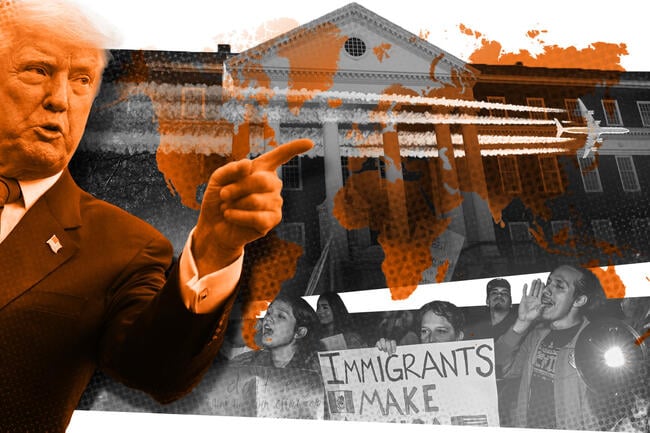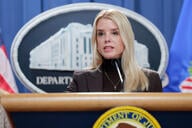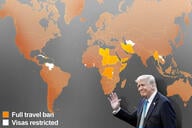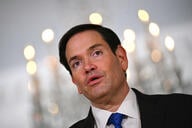You have /5 articles left.
Sign up for a free account or log in.

Even a small reduction in the number of international students could be devastating for U.S. colleges.
Photo illustration by Justin Morrison/Inside Higher Ed | Andrew Harnik/Getty Images | Giorgio Viera/AFP/Getty Images | Shuke Li/iStock/Getty Images | Rawpixel
Almost three months after the arrest of Columbia University graduate Mahmoud Khalil, international students in the U.S. still face unprecedented challenges and threats from the federal government. For many, this semester has been a roller coaster of existential fear, fleeting hope and, above all, uncertainty about their future.
In March, Immigration and Customs Enforcement agents began targeting student protesters who expressed pro-Palestinian views, arresting them on the streets or in their homes and detaining them in remote migrant facilities for months at a time. In April, they expanded their dragnet and began terminating thousands of students’ legal residency at institutions across the country, from Columbia to community colleges. Students were targeted for everything from vague allegations of “foreign policy threats” to minor traffic violations.
By the end of the April, the administration faced dozens of lawsuits challenging those revocations, dozens of which resulted in temporary injunctions. The Trump administration, caught in a legal bind, reversed course and restored thousands of students’ SEVIS statuses.
But that wasn’t the end of the White House’s war on international students. In early May, the Department of Homeland Security gave ICE more leeway to revoke students’ statuses with little justification. And more recently, the Trump administration has focused its campaign on a few specific international student populations: recent graduates on Optional Practical Training, students at Harvard University and students from China, who Secretary of State Marco Rubio claims are more likely to be national security threats.
Now, with the critical summer visa application season approaching, the State Department has halted all new visa interviews as it implements a rigorous social media vetting process. In a letter to Rubio, dozens of higher ed leaders wrote that the pause jeopardizes accepted international students’ ability to enroll in classes on time and “sends a message that our nation no longer welcomes talented students and scholars from other countries.” Current international students are weighing the risks of returning home for summer break, while prospective ones are considering the benefits of applying to college in the U.S. at all.
Here are five updates from the past month on the administration’s evolving policies and practices regarding international students—and where they’re headed next.
China in the Crosshairs
Last week Rubio announced that the State Department would begin “aggressively revoking” visas for Chinese international students. Rubio said the agency will target those suspected of affiliating with the Communist Party or those who work in “critical fields” adjacent to national security concerns, but the vague language has higher ed leaders worried about just how broad the dragnet will be.
Nearly 280,000 Chinese students study in the U.S., a quarter of the total international student population. If the country’s largest group of foreign students is significantly curtailed, that could spell disaster for a wide swath of higher education institutions, from small private colleges to large public research universities.
President Trump has called the new State Department policy essentially a souped-up review process and said Chinese students are “going to be OK.” But even if the number of Chinese student visa revocations is ultimately small, the impact on future enrollment is sure to be deleterious.
Along with the heightened scrutiny of Chinese students’ visa applications, the rhetoric from officials and the current political climate could deter some Chinese families from considering American universities at all. That could decimate international enrollment. Other large foreign student populations, like those from India and Bangladesh, likely wouldn’t be able to make up for the lost revenue or research prowess even if their numbers rose rapidly. And with more families nervous about sending their children to study in the U.S., a rapid rise isn’t likely.
Weaponizing the SEVP
Meanwhile, the Trump administration is trying to revoke Harvard University’s ability to enroll international students, the latest escalation in the federal government’s ongoing war with the university. Harvard sued and a federal judge quickly ordered a temporary stay on the decision. But if it passes legal muster, the revocation would be financially disastrous for Harvard, where more than a quarter of the student body is international, and likely devastating for the thousands of students forced to transfer or leave the country.
The move also sets a dangerous precedent beyond the Ivy-clad gates of the Cambridge institution. The Student Exchange and Visitor Program is responsible for approving institutions to enroll international students; historically, its duties have been primarily about rooting out rare cases of fraud, ensuring that degree programs had educational merit and weren’t just fronts for faster, easier visas. After revoking Harvard’s certification for SEVP, Trump officials warned that other colleges could face a similar fate.
The decision to weaponize SEVP threatens a major source of revenue for thousands of legitimate colleges just as they face financial hardship from withheld research grants and enrollment downturns. That, in turn, could lower institutions’ financial aid offerings and even prompt tuition hikes.
OPT Under Threat
International students on Optional Practical Training, the postcompletion program that allows recent graduates to extend their visas to gain experience in a field relevant to their studies, face the most immediate danger. Two weeks ago, immigration officials began targeting those OPT participants who had failed to report employment within the required timeline, warning that their status in the Student Exchange and Visitor Information System would be terminated and they could be deported.
Trump’s nominee to head up U.S. Citizenship and Immigration Services, Joseph Edlow, is a harsh OPT critic as well. He told the Senate Judiciary Committee in late May that he felt the program “had been a real problem” under former president Joe Biden and signaled that he’s open to tightening the restrictions or even restructuring OPT entirely.
In 2023–24, nearly a quarter million recent graduates were on OPT or STEM-OPT visa extensions, according to data from the Institute for International Education. Under Trump, there could be far fewer.
New SEVIS Policy Looms
After a string of losses in courts, Immigration and Customs Enforcement released a new policy in early May outlining acceptable reasons for terminating students’ residency status. The new policy came just a few weeks after the Department of Homeland Security restored thousands of students’ SEVIS records.
The new policy gives ICE an expansive mandate to terminate students’ SEVIS status, asserting that immigration officials have “inherent authority” to do so “as needed.” It also explicitly lays out two new justifications for SEVIS terminations: the vague “evidence of failure to comply” with nonimmigrant visa terms, or a visa revocation, which the State Department can do practically at will.
ICE has now paved the way for the Trump administration to resume a campaign of mass deportation of international students. That hasn’t happened, but the stage is set for the first broad efforts since the SEVIS restorations, potentially starting with the 280,000 Chinese students in the U.S. And with Harvard’s international students in the crosshairs, the new policy could also make it easier for the administration to target students at specific institutions.
Heightened Visa Scrutiny
Last week, Rubio announced a new policy requiring all student and exchange visa applicants to undergo rigorous social media vetting and halted all new interviews while the policy is implemented. And on Thursday, he said the department would review application criteria to “enhance scrutiny of all future visa applications” from China and Hong Kong.
The State Department is formalizing a practice that has allegedly been widespread at U.S. consulate offices since Trump took office. Students applying to enter the country this year have reported major delays at visa offices, unusually thorough social media reviews and ideological litmus tests, including support for Israel and for President Trump’s agenda.
International students continue to file lawsuits challenging the Trump administration’s power to revoke student visas in the volume and speed they’ve proposed, and some have already succeeded.
But whether the administration attempts to deport a critical mass of students or simply makes it much harder to acquire a visa in the future, colleges are bracing for an impact on enrollment. This spring’s twists and turns have made international students fearful for their future, undermined recruiters abroad and thrown colleges’ financial planning into deep uncertainty.
“We’re seeing a real chilling effect on international student applications and enrollment from this whole slate of international policy coming out of the White House,” Marjorie Hass, president of the Council of Independent Colleges, told Inside Higher Ed last week. “That’s very significant.”





